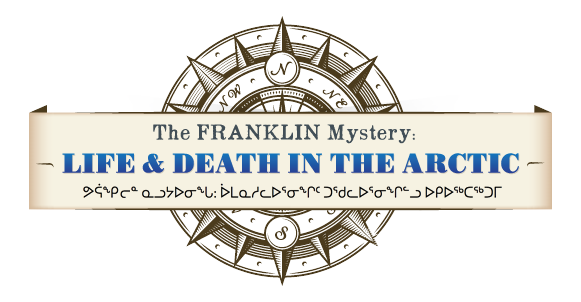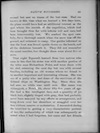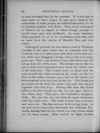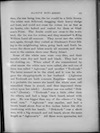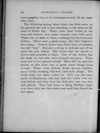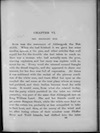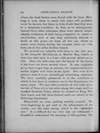Ahlangyah’s Testimony to Schwatka [as reported by Gilder] (1881)
That night Equeesik learned from two natives who came in late that his sister was with another portion of the tribe near Richardson Point, and went there with his sled, returning the next day but one with several families, including an old woman whom we found to be another important and interesting witness. She was one of a party who met some of the survivors of the ill-fated ships on Washington Bay. Since then she had seen no white man until now. Her name was Ahlangyah, a Netchillik, about fifty-five years of age. She had a fine intelligent face, and a quantity of jet black hair, slightly tinged with gray, that had probably never been annoyed by any efforts at arrangement, and hung down over her shoulders or straggled over her face without reserve or molestation. I succeeded during the interview in getting a very characteristic portrait of her, the authenticity of which was subsequently attested when I had forgotten her name and her friends at once identified her by the portrait. It is but fair to state that we have reason to put great faith in the statements of these people, as truthfulness seems to be an inherent quality with them. They never attempted to deceive us in regard to relics, though perhaps it would seem easy and profitable. In many instances what appeared to us to be interesting relics they told us came from the natives of Repulse Bay and elsewhere.
Ahlangyah pointed out the eastern coast of Washington Bay as the spot where she, in company with her husband, and two other men with their wives, had seen ten white men dragging a sledge with a boat on it many years ago. There was another Inuit with them who did not go near the white men. The sledge was on the ice, and a wide crack separated them from the white men at the interview. The women went on shore, and the men awaited the white people at the crack on the ice. Five of the white men put up a tent on the shore, and five remained with the boat on the ice. The Inuits put up a tent not far from the white men, and they stayed together here five days. During this time the Inuits killed a number of seals on the ice and gave them to the white men. They gave her husband a chopping-knife. He was the one who had the most intercourse with the white crew. The knife is now lost, or broken and worn out. She has not seen it for a long time. At the end of five days they all started for Adelaide Peninsula, fearing that the ice, which was very rotten, might not let them across. They started at night, because then, the sun being low, the ice would be a little frozen. The white men followed, dragging their heavy sledge and boat, and could not cross the rotten ice as fast as the Inuits, who halted and waited for them at Gladman's Point. The Inuits could not cross to the mainland, the ice was too rotten, and they remained in King William Land all summer. They never saw the white men again, though they waited at Gladman's Point fishing in the neighboring lakes, going back and forth between the shore and lakes nearly all summer, and then went to the eastern shore near Matty Island.
Some of the white men were very thin, and their mouths were dry and hard and black. They had no fur clothing on. When asked if she remembered by what names the white men were called, she said one of them was called "Agloocar," and another "Toolooah." The latter seemed to be the chief, and it was he who gave the chopping-knife to her husband. (Agloocar and Toolooah are both common Esquimaux names, and it is probable the names she heard the white men call resembled these in sound, and thus impressed themselves upon her mind.) Another one was called "Doktook " (Doctor). "Toolooah " was a little older than the others, and had a large black beard, mixed with gray. He was bigger than any of the others - "a big, broad man." "Agloocar " was smaller, and had a brown beard about four or five inches below his chin (motioning with her hand). "Dok-took " was a short man, with a big stomach and red beard, about the same length as "Agloocar's." All three wore spectacles, not snow goggles, but, as the interpreters said, all the same seko (ice).
The following spring, when there was little snow on the ground, she saw a tent standing on the shore at the head of Terror Bay. There were dead bodies in the tent, and outside were some covered over with sand. There was no flesh on them - nothing but the bones and clothes. There were a great many ; she had forgotten how many. Indeed, Inuits have little idea of numbers beyond "ten." She saw nothing to indicate any of the party she met before. The bones had the chords or sinews still attached to them. One of the bodies had the flesh on, but this one's stomach was gone. There were one or two graves outside. They did not open the graves at this time; saw a great many things lying around. There were knives, forks, spoons, watches, many books, clothing, blankets, and such things. The books were not taken notice of. This was the same party of Esquimaux who had met the white men the year before, and they were the first who saw the tent and graves. They had been in King William Land ever since they saw the white men until they found the tent place.
Such was the statement of Ahlangyah the Netchillik. When she had finished it we gave her some needles, spoons, a tin pan, and other articles that well repaid her for the trouble she had taken to reach us. Here was a woman who had actually seen the poor, starving explorers, and her story was replete with interest for us. Every word she uttered seemed fraught with the dread tragedy, and she appeared to share our interest, for her face was full of expression. At times it was saddened with the recital of the piteous condition of the white men, and tears filled her eyes as she recalled the sad scene at the tent place where so many had perished, and their bodies become food for wild beasts. It would seem, from what she related to-day, that the party which perished in the inlet we visited yesterday, was part of the same that Ahlangyah met on King William Land. She and her friends could not get across Simpson Strait, while the white men kept on over the rotten ice, probably at last compelled to take to their boat, and then, at the mercy of the wind and ice, after losing others of their number near Pfeffer River and Todd Islands, had drifted into the inlet where the dead bodies were found with the boat. How long it took them to reach this place will probably never be known, but there is little doubt that they were in a desperate condition. In fact, as we subsequently learned from other witnesses, there were almost unmistakable evidences of their being compelled to resort to cannibalism, until at last they absolutely starved to death at this point - at least all but one, whose remains were found, during the summer after our visit here, about five miles further inland.

